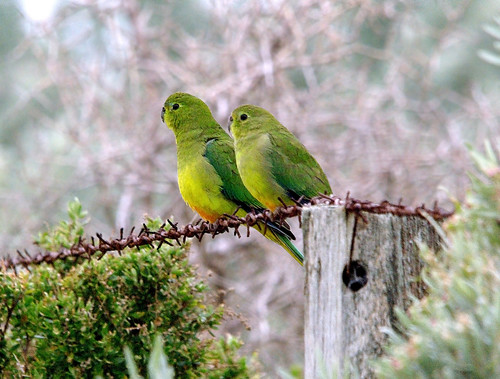Rare parrots flock south west of Melbourne
 Wednesday, November 2, 2011 at 2:01
Wednesday, November 2, 2011 at 2:01  Orange Bellied parrots. Image by OwenYB
Orange Bellied parrots. Image by OwenYB
One of the world's rarest parrots has been spreading its wings south-west of Melbourne.
A national survey to record sightings of the threatened Orange-bellied parrot found the species was flocking between Queenscliff on the Bellarine Peninsula and Werribee during its time on the mainland.
Experts say fewer than 50 of the birds are left in the wild.
But they were buoyed by 26 separate recorded sightings of the parrots, ranging from one to six birds, in this area.
Peter Menkhorst, from the Department of Sustainability and Environment, said it was a great effort to find such a big proportion of what remains of the small, bright-green parrot with yellow underparts, during winter.
"With 1200 kilometres of Australia's coast to choose from in South Australia and Victoria, all but three sightings of Orange-bellied parrots in 2011 were in this relatively small area," he said.
Another three sightings, each of two birds, were in South Australia.
The biggest single sighting of the bird, whose scientific name is Neophema chrysogaster, was of six birds.
Craig Morley, who coordinated the winter count for the Bellarine Peninsula, said skilled volunteers checked as many locations as they could during three surveys in May, July and September.
"They spent many cold and wet hours searching islands, salt marshes, sewage farms, paddocks and golf courses, including places where the species has been seen before," he said.
At three sites, food was provided to the parrots to help them through winter in the hope they will arrive on Tasmanian breeding grounds in top shape for the coming breeding season.
Experts are also hoping for another good breeding season for a captive population at Healesville sanctuary.
The area between Queenscliff and Werribee has been a stronghold for the winter population of Orange-bellied Parrots since at least the 1970s.
Varying numbers have also travelled to the coasts of western Victoria, South Australia and less often to Western Port and Gippsland.
The Commonwealth, Victorian, Tasmanian and South Australian governments, Zoos Victoria, Adelaide Zoo, Birds Australia, the Tasmanian Conservation Trust, experts and community members are all involved in the project.

